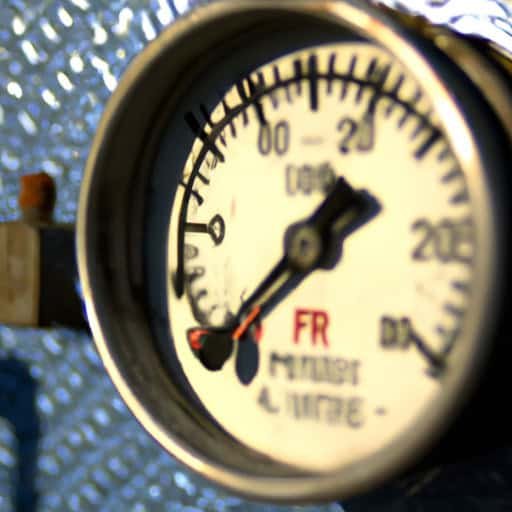Is your well pump working efficiently? If you want to ensure that it is, there are a few things you can do. Regular maintenance and inspections are key to keeping your well pump running smoothly. Additionally, monitoring the pressure and flow rate can help you detect any potential issues early on. In this article, we will explore some simple tips and tricks to ensure that your well pump is working efficiently so that you can access clean and reliable water whenever you need it.

Regular Maintenance
Inspect the well pump on a regular basis
Regularly inspecting your well pump is essential to ensuring its efficient operation. Take the time to visually inspect the pump for any signs of damage or wear. Look for leaks, cracks, or corrosion on the pump casing. Additionally, inspect the electrical components and wiring for any signs of damage or loose connections.
Clean the pump and surrounding area
Keeping your well pump clean is another crucial aspect of maintenance. Dirt, debris, and leaves can accumulate around the pump, potentially causing blockages or hindering its performance. Regularly clean the pump and the area surrounding it to eliminate any potential issues.
Check the electrical connections
A well pump relies on a proper electrical connection to function effectively. Inspect the wiring and connections to ensure they are secure and free from any damage. Loose or corroded connections can lead to a drop in performance or even electrical hazards. If you notice any issues with the electrical connections, it’s advisable to seek professional assistance.
Test the pressure and flow
Testing the pressure and flow of your well pump is crucial for maintaining its efficiency. Use a pressure gauge to measure the water pressure and observe the flow rate. If you notice a significant drop in pressure or an unusually weak flow, this may indicate a problem with your pump. In such cases, it’s recommended to consult a professional for further inspection and necessary repairs.
Consider professional servicing
While regular maintenance tasks can help you keep your well pump in good working condition, it’s often beneficial to consider professional servicing. By scheduling routine service visits from a qualified well pump technician, you can ensure that your pump receives a thorough inspection, cleaning, and any necessary repairs. Professional servicing can help identify potential issues early on, preventing major problems down the line.
Ensuring Proper Installation
Follow manufacturer’s instructions
When installing a well pump, it’s crucial to carefully follow the manufacturer’s instructions. The instructions provided are specific to each pump model and provide valuable guidance for a proper installation. Failure to follow these instructions may result in a pump that doesn’t perform optimally or has a shorter lifespan.
Choose the right pump size
Selecting the appropriate pump size is essential for ensuring efficient water supply and preventing unnecessary strain on the pump. Consider factors such as the depth of the well, the required flow rate, and the size of your household’s water demand. Consulting with a well pump professional can help you determine the correct pump size for your specific needs.
Properly position the pump
The position of your well pump can significantly impact its efficiency. Ensure that it is installed in a location that provides easy access for maintenance and inspection. Additionally, proper positioning can help minimize the risk of damage from flooding or other external factors.
Check for leaks in the system
After installation, it’s important to thoroughly check the entire system for any leaks. Leaks can lead to water wastage and put additional strain on the pump. Inspect all pipes, fittings, and connections for signs of leaks and promptly address any issues to maintain the efficiency of your well pump.
Maintaining Water Quality
Test the water quality
Regularly testing your well water quality is crucial to ensure that it is safe for consumption. Test for contaminants such as bacteria, chemicals, and heavy metals. Monitoring the water quality will help you identify any concerns and take appropriate measures to maintain clean and healthy water.
Install a water filtration system
Installing a water filtration system can further enhance the quality and taste of your well water. There are various filtration options available, including activated carbon filters, reverse osmosis systems, and UV disinfection. Choose a filtration system that suits your specific needs and consult a professional for proper installation.
Regularly clean or replace filters
If your well pump system includes filters, it’s important to regularly clean or replace them as recommended by the manufacturer. Over time, filters can become clogged with debris and contaminants, reducing their effectiveness and straining the pump. By maintaining clean filters, you can ensure optimal water flow and quality.
Avoid using harsh chemicals
When maintaining water quality in your well system, it’s essential to avoid using harsh chemicals that can affect the pump and water supply negatively. Chemicals such as bleach or strong cleaning agents can corrode the pump components and contaminate the water. Opt for more gentle and well-suited cleaning solutions to protect the integrity of your well pump and water quality.
Monitoring Energy Usage
Check the power consumption
Monitoring the power consumption of your well pump is an effective way to ensure its efficiency. Keep track of your energy bills and compare them to previous periods. A significant increase in power consumption may indicate a problem with your pump or system. If you notice a sudden spike in energy usage, it’s advisable to consult a professional to assess the situation.
Consider energy-efficient options
If you’re looking to reduce your energy consumption and minimize the environmental impact, consider upgrading to an energy-efficient well pump. Energy-efficient pumps are designed to consume less electricity while still providing the required water flow and pressure. These pumps can save you money in the long run and contribute to a greener footprint.
Use a timer or pressure switch
Installing a timer or pressure switch can help regulate the operation of your well pump and reduce unnecessary energy usage. By programming the pump to run during specific times or when the pressure drops below a certain threshold, you can optimize its efficiency. These devices can be easily integrated into your well pump system and are worth considering for energy-conscious individuals.

Protecting Against Power Outages
Install a backup generator
Power outages can disrupt the operation of your well pump, leaving you without water supply. Installing a backup generator can provide peace of mind, ensuring that your pump continues to function during power interruptions. A backup generator will automatically kick in when the main power source fails, keeping your water supply uninterrupted.
Use a battery backup system
Another option to safeguard against power outages is to utilize a battery backup system. This system stores electricity from the main power source and can provide power to the well pump during outages. Battery backup systems are especially useful in areas with frequent power disruptions or in situations where a backup generator is not practical.
Invest in a water storage tank
Having a water storage tank is an effective way to prepare for power outages and ensure continuous water supply. The tank can be filled during periods of regular power supply and serve as a reservoir during power interruptions. With a proper water storage tank, you can maintain access to water even when your well pump is temporarily unavailable.
Preventing Freezing and Frost Damage
Insulate the well house or pump room
Proper insulation is crucial for protecting your well pump from freezing temperatures. Insulate the well house or pump room to help maintain a stable and warmer environment. This insulation will prevent freezing and frost damage to the pump and its components, ensuring its efficiency during winter months.
Protect exposed pipes and fittings
Exposed pipes and fittings are susceptible to freezing and can cause significant damage to your well pump system. Insulate these vulnerable areas with pipe insulation sleeves or heat tape. By safeguarding exposed parts, you can prevent freezing-related issues and maintain a reliable water supply.
Install a heat source
Installing a heat source, such as a heater or heat lamp, in the well house or pump room is an effective measure against freezing and frost damage. The heat source will help maintain a consistent temperature, preventing freezing and ensuring the optimal operation of the well pump. Ensure the heat source is safe and appropriate for the enclosed space.
Keep the pump running during freezing temperatures
During freezing temperatures, allowing your well pump to run continuously can help prevent freezing within the system. Running water is less likely to freeze, making continuous pumping an effective prevention measure. However, it’s essential to monitor the pump and ensure that all other components are properly insulated to avoid any damage.

Regular Well Inspections
Inspect the well for cracks or damage
Regularly inspecting your well for any signs of cracks, damage, or deterioration is essential for its longevity and efficiency. Check the well casing for any visible cracks or shifts. Additionally, pay attention to the well cap, seals, and any exposed equipment. If you notice any signs of damage, consult a well professional for further evaluation and necessary repairs.
Check the water level
Monitoring the water level in your well is crucial to ensure its proper operation. Ensure that the water level remains consistent over time, as significant fluctuations can indicate a problem, such as a failing pump or a decline in the well’s water supply. If you notice any unusual changes in the water level, it’s advisable to seek professional guidance.
Monitor well production
Regularly monitoring the production of your well pump is important for understanding its efficiency and performance. Keep track of the amount of water your well produces over time and compare it to previous periods. A sudden decrease in well production may indicate a problem with your pump or system, and professional assistance should be sought to address the issue.
Maintaining Proper Water Pressure
Check and adjust the pressure switch
The pressure switch plays a crucial role in regulating the water pressure in your well pump system. Regularly check the pressure switch settings and ensure they align with your desired water pressure. If necessary, make adjustments following the manufacturer’s instructions. A pressure switch that is incorrectly set can lead to fluctuating or inadequate water pressure.
Ensure proper pressure tank sizing
Proper sizing of the pressure tank is essential for maintaining optimal water pressure and minimizing the strain on the pump. Consult a well professional to determine the appropriate pressure tank size based on your specific water demands and pump capacity. Using an incorrectly sized pressure tank can result in frequent cycling and reduced pump efficiency.
Monitor pressure fluctuations
Keep an eye on pressure fluctuations within your well pump system. Significant changes in water pressure can indicate issues with the pump, pressure tank, or other components. Regular monitoring allows you to detect pressure-related problems early on and seek professional assistance for timely repairs, ensuring consistent and efficient water pressure.
Addressing Common Issues
Low water pressure
If you’re experiencing low water pressure, several factors could be contributing to the problem. Inspect the pressure switch, pressure tank, and pipes for any blockages or leaks. Additionally, check the well’s water level and monitor pump performance. Identifying and addressing the root cause of low water pressure will help restore optimal flow and pressure.
Air in the water lines
The presence of air in your well pump system can result in sputtering faucets and reduced water flow. Check for any leaks or cracks in the pipes, fittings, or pressure tank that may be introducing air into the system. It’s important to promptly address any air-related issues to prevent damage to the pump and ensure a steady water supply.
Frequent cycling on and off
Frequent cycling of the well pump, where it turns on and off repeatedly, can indicate a problem within the system. Potential causes include a malfunctioning pressure switch, improper pressure tank sizing, or a declining water supply. Consult with a well pump professional to diagnose the issue accurately and implement the necessary repairs or adjustments.
Strange noises or vibrations
Unusual noises or vibrations from your well pump should not be ignored as they could indicate underlying problems. Grinding, rattling, or squealing sounds, as well as excessive vibrations, may signify damage to the pump or its components. If you notice any abnormal noises or vibrations, it’s best to have a professional inspect and address the issue promptly.
Considering Upgrades
Upgrade to a variable speed pump
Consider upgrading to a variable speed pump to enhance the efficiency and performance of your well pump system. Unlike traditional pumps that operate at a constant speed, variable speed pumps adjust their speed based on water demand. This results in energy savings, reduced wear and tear, and a more consistent water pressure.
Upgrade to a submersible pump
If you currently have a jet pump, upgrading to a submersible pump can offer several benefits. Submersible pumps are typically more efficient and quieter compared to jet pumps. They are also better suited for deeper wells. Upgrading to a submersible pump can provide improved water flow, reduced energy consumption, and longer pump lifespan.
Install a constant pressure system
A constant pressure system is a valuable upgrade that ensures a consistent water pressure throughout your home, regardless of varying demands. This system utilizes advanced technology to maintain a stable pressure, eliminating pressure fluctuations during simultaneous water usage. Installing a constant pressure system can greatly enhance the convenience and efficiency of your well pump system.
In conclusion, ensuring the efficient operation of your well pump requires regular maintenance, proper installation, water quality management, energy monitoring, protection against power outages, prevention of freezing damage, regular inspections, maintaining proper water pressure, addressing common issues, and considering potential upgrades. By following these guidelines and consulting with well pump professionals when needed, you can maximize the lifespan, efficiency, and reliability of your well pump system. Remember, taking care of your well pump not only ensures a consistent water supply but also contributes to the health and well-being of your household.

